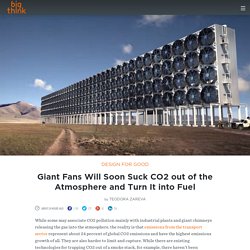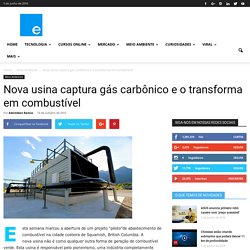

Giant Fans Will Soon Suck CO2 out of the Atmosphere and Turn It into Fuel. By Teodora Zareva While some may associate CO2 pollution mainly with industrial plants and giant chimneys releasing the gas into the atmosphere, the reality is that emissions from the transport sector represent about 24 percent of global CO2 emissions and have the highest emissions growth of all.

They are also harder to limit and capture. While there are existing technologies for trapping CO2 out of a smoke stack, for example, there haven’t been solutions for capturing the amount already released into the atmosphere (by cars, trucks, and planes) — CO2 that is 300 times less concentrated than the type coming out of a smoke stack. That is until now. In the beginning of this year, in Squamish, British Columbia, the privately owned (and backed by Bill Gates) company Carbon Engineering began the construction of the first air-capture CO2 demo plant. Like trees, air-capture technology traps CO2 from the ambient air. Photos: Carbon Engineering.
Carbon Engineering - Industrial-scale capture of CO2 from ambient air. Scientists successfully generate gasoline out of thin air. Gasoline is the quintessential non-renewable fuel, but British scientists could soon change that. They have developed a way to make gasoline not only renewable, but also carbon neutral. How is that possible? By plucking the fuel out of the air, according to New Scientist .
It sounds like alchemy or magic — an idea about as sensible as growing money on trees. But it's real. Here's basically how it works: first scientists collect carbon, hydrogen and oxygen from the CO2 and water that are readily present in the air. It seems so simple that you may wonder why we haven't been getting our gasoline this way all along. That's where British company Air Fuel Synthesis comes in. "I take my hat off to Air Fuel Synthesis.
The fuel is not only viable; the company believes it will be suitable for high-performance vehicles. Another potential benefit of the fuel is that it will be price-predictable. You can view a BBC presentation about the technology in the video at top. Related stories on MNN: Fuel from the Air: Sossina Haile at TEDxBermuda. Creating Roads From Sand and Bacteria Instead of Oil.
Improving America’s infrastructure has been a major priority for the Obama Administration, with a lot of money going into repairing the country’s roads and bridges.

The problem is that currently most roads are constructed from asphalt, a material made from oil that increases national fossil fuel usage, is expensive, and is damaging to the environment. However designers Thomas Kosbau and Andrew Wetzler have come with a plan for a greener alternative — a “biologically treated and processed paving material” that uses a common microbe to transform loose grains of stand into stable, road-worthy sandstone.
The plan, called ‘Sand.Stone.Road‘ recently won the grand prize in the Korean green design ‘Iida Awards 2010‘, which were organized by Designboom in collaboration with Incheon Metropolitan City. In the designers’ own words, “The world is suffering from a material found outside of every doorway. Asphalt has been used as the conventional paving material for the last 80 years. Nova usina captura gás carbônico e o transforma em combustível. Esta semana marcou a abertura de um projeto “piloto”de abastecimento de combustível na cidade costeira de Squamish, British Columbia.

A nova usina não é como qualquer outra forma de geração de combustível verde. Esta usina é responsável pelo pioneirismo, uma indústria completamente nova de refino de combustíveis utilizando o dióxido de carbono capturado do ar. Ela não foi projetada para ou capaz de reduzir os gases mensuráveis do efeito estufa na atmosfera. Em vez disso, a motivação da criação da usina é a produção de combustíveis para serem aplicados em transportes pesados, como aviões, caminhões e ônibus. David Keith, o fundador da Carbon Engineering, empresa que construiu a usina piloto afirma que uma vez que a usina está em sua plena eficiência, o sistema será capaz de retirar cerca de uma tonelada de dióxido de carbono por dia. Tais como painéis solares, o processo precisa ser bem implementado para que a usina seja economicamente valiosa.